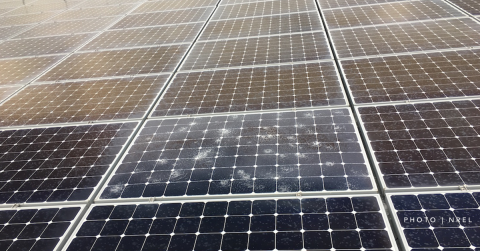A severe hailstorm pelted the Denver area on May 8, leaving a trail of destruction in its wake. But, the National Renewable Energy Laboratory's solar panels held strong with just one broken panel out of more than 3,000.
Office of Critical Minerals and Energy Innovation
May 15, 2017The Denver area was pelted with an unusually severe hailstorm on May 8 – one that left a trail of destruction in its wake, shattering car windows and leaving golf ball-sized dents on the roofs of local homes and vehicles.
After the storm, staff at the National Renewable Energy Laboratory (NREL) set out to assess the damage. Its main campus in Golden, Colorado boasts more than 2.5 megawatts of photovoltaic (PV) power. A majority of those panels (more than 3,000) are located on or adjacent to the roof of the lab’s Research Support Facility, a net-zero energy building. The post-storm inspection revealed just one broken panel.
PV Strong
This news wasn’t a total shock to NREL researchers. They work closely with the U.S. Department of Energy’s SunShot Initiative to improve the durability of solar modules. Included in the testing is the requirement to survive hail stone impact. In fact, the test requires shooting ping-pong-ball-sized ice balls at PV modules in multiple places at about 70 miles per hour. In the case of this hailstorm, the one glass module cover that cracked was apparently simultaneously hit by a number of hailstones in almost the exact same place. This concentrated blow created a network of micro-cracks in the glass. Subsequent hailstones then left their “footprints” of impact in that web of small fractures, which tally to what appears to be more than three-dozen hits.
NREL researchers are funded by SunShot to participate in the International Photovoltaic Quality Assurance Task Force, which develops standardized industry quality tests to assure that solar panels on the market can survive the harsh environmental conditions to which they are directly exposed. This includes not only how panels react to mechanical stress, such as hail or being walked on, but also high and low temperatures, humidity, solar ultraviolet radiation, and even the electrical stress that the panels apply to themselves when operating in high-voltage systems. These quality standards help reinforce consumer and investor confidence in PV.
NREL also leads a group that brings together national labs and universities with the solar supply-chain industries to discover, develop, de-risk, and enable the commercialization of new materials and designs for PV modules. The durable module materials consortium focuses on accelerating the research and development of high-performance PV packaging materials and module architectures in order to increase module reliability and performance while decreasing module costs. These efforts will continuously improve the durability and performance of solar panels while driving down the cost of solar electricity.
NREL’s research demonstrates that solar energy systems are resilient through extreme weather events like hail and hurricanes – and the events of May 8 further underscore the benefits of going solar.



